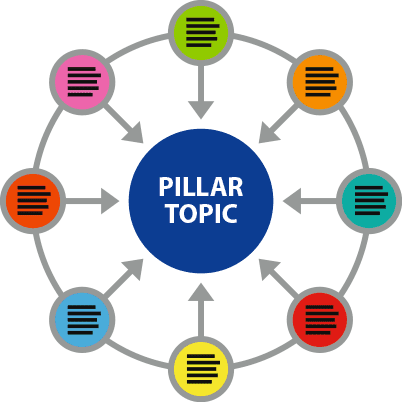Content Cluster: A Comprehensive and Organized Content Strategy
Are you seeking methods to improve your website’s SEO and increase traffic? If so, the content cluster model may just be what you need. This model organizes content into clusters with a central pillar page, creating a more comprehensive and organized content marketing strategy.
The idea behind the topic cluster model is simple: create new content around a central pillar. The pillar page is the main hub for information on a particular topic, while the cluster pages provide additional information on related subtopics. Unlocking the potential of content clusters involves creating interconnected pieces of content that link to the cluster page and delve deeper into specific subtopics.
This strategic approach enables you to generate more content around your chosen topic, enhancing your website’s search engine optimization (SEO). Search engines like Google and Bing favor websites that offer a comprehensive and high-quality range covering various relevant subjects. By developing clusters of related content, you can show search engines your website is an authoritative source on the chosen subject matter.
Additionally, the content cluster model provides the advantage of organizing your website’s content logically and coherently. Visitors will appreciate having all the pertinent information on a specific topic conveniently located in one place. Furthermore, incorporating strategic internal linking and connections between different pieces of related content can prolong visitor engagement on your site.
Select a central pillar topic or theme for your website to begin creating a content cluster. It should be broad enough to encompass multiple subtopics yet manageable to maintain focus. Subsequently, brainstorm ideas for subtopics directly relevant to the chosen theme.
Once you have identified subtopics, develop individual pages or posts for each. These pieces of content should interlink with the central pillar page and one another when appropriate. Consider incorporating internal links or referencing related topics from other pages on your site.
As you continue creating new content, remember to align it with your existing content cluster, ensuring a cohesive and comprehensive user experience. Try to create unique content supporting articles that fit into one of your existing subtopics or add a new subtopic to your collection if necessary.

What Is a Content Cluster?
Content cluster is a strategy used in SEO to organize website content into related topics. It involves creating a main topic page that links to several subtopic pages, forming a content cluster. The subtopic pages are connected to the site architecture’s main topic page, creating a network of internal links that boosts SEO.
Why Does Topic Cluster Matter for SEO?
Search engines use complex logic algorithms to determine the relevance of websites on particular topics. Websites can use content clusters to signal their expertise and site authority on a subject and improve their search engine results page rankings.
Moreover, topic cluster help search engines understand the association between different pieces of content on your website. When search engines traverse your site and find multiple pages linking back to one another within the same topic area or theme (i.e., your content clusters), they will recognize that those pages are relevant to each other and assign them higher value.
How Can You Implement a Content Cluster on Your Website?
Choose Your Main Topic
The first step in implementing a content cluster strategy is choosing your main topic or pillar page. This broad topic should cover all aspects of what you want to write about – think “everything you need to know about X.” If you are an owner of a food blog, your main topic could be “cooking.”
Identify Subtopics
Once you’ve chosen your main topic, it’s time to identify subtopics or clusters within that broader theme. These areas should be within the article you want to cover in depth. For example, within the “cooking” topic, you could have subtopics like “baking,” “grilling,” and “meal planning.”
Create Content
Once you’ve identified your subtopics, it’s time to create content. Each subtopic should have an in-depth page or blog post covering that area. Be sure to add links link back to your main topic page from each subtopic page.
Link Everything Together
Finally, link everything together. Your main topic page should relate to each subtopic page, and each should link back to your main topic page. This creates a network of internal links that signals to search engines the relevance of producing quality content and your website’s authority on a particular subject.

Establishing Your Brand as an Authority with Topic Clusters
Using Topic Clusters to Build Your Brand’s Authority
Organizing your content into a topic cluster establishes your brand as an authority in your industry. By grouping related topics, you can demonstrate your expertise and provide a comprehensive resource for your audience. But how does this help build authority? Let’s explore the role of domain authority and how topic clusters can improve it.
Domain Authority and its Role in Building Authority
Domain authority is a metric system that predicts how a website will rank on search engine result pages. It takes backlinks, the quality of those links, and the overall trustworthiness of the website into consideration. The higher number of these scores, the more likely you rank higher on SERPs.
Building domain authority takes time and effort. You must consistently produce high-quality content that attracts backlinks from other reputable websites. This is where topic clusters come in.
Using Topic Clusters to Improve Domain Authority
When you create topic clusters, you create a hub of information around a particular subject. Using topic clusters matter, linking all related content within that topic cluster mistakes, and together, you’re signaling to search engines that these pages are all relevant and authoritative. This helps improve your website’s overall domain authority score.
The SEO Impact of Topic Clustering
Organize Your Website with Topic Clustering
Topic clustering is a powerful SEO strategy that can help improve website organization and user experience. By grouping related content into clusters, websites can increase their relevance for multiple keywords, reducing issues like keyword cannibalization and content duplication. In this section, we’ll explore the impact of topic clustering on SEO and how it can benefit your website.
Reduced Keyword Cannibalization and Content Duplication
Another significant advantage of topic clustering is that it reduces keyword stuffing, cannibalization, and content duplication issues.
By organizing related content into clusters, websites can avoid duplication problems by ensuring that each page targets unique keywords and provides valuable information to users. This technique improves search engines to crawl and index your site since they won’t have to sift through duplicate or competing content.
Encourages Internal Linking
Topic clustering also encourages internal linking, distributing link equity throughout your site and strengthening overall domain authority. When you create clusters of related content, you can link between them using relevant anchor text, providing users with additional resources while signaling to search engines which pages are most important.
Internal links also help establish topical authority for your site by showing search engines which topics you cover in-depth. By linking related content, you can let the engines know that your website is an authentic source of information on a particular topic.
Thorough Keyword Research and Planning
Implementing topic clusters requires thorough keyword research and planning. You’ll need to identify the main topics or themes your website covers and then create groups of related content around those topics. This process involves analyzing search data, identifying relevant keywords, and creating content that provides users value.
While implementing topic clustering on your site may take time and effort, the long-term benefits are well worth it. Organizing your content into clusters can improve relevance for multiple keywords, reduce issues like keyword cannibalization and content duplication, encourage valuable internal linking opportunities, and establish topical authority for your site.

Topic Clusters and Content Marketing
Enhancing Digital Marketing Efforts with Content Clusters
Creating topic clusters is vital for optimizing digital marketing efforts and improving keyword rankings. With too many blog posts scattered across a website, internal linking is crucial to enhance the user experience and boost search engine visibility.
By identifying content gaps and utilizing long-tail and informational keywords, a content cluster strategy can be devised to organize the existing content and generate new ideas. Multiple topic clusters can be established, each consisting of in-depth content that covers various aspects of a particular topic.
Adding internal links within and across these clusters strengthens the website’s architecture. It helps search engines understand the relation and interconnectedness of the content, ultimately driving organic traffic and improving overall user engagement.
For digital marketers, embracing the concept of content clusters and implementing effective internal linking techniques can lead to more cohesive and impactful digital marketing campaigns.
Creating a Topic Cluster Strategy
To create a compelling topic cluster, you must first identify a core topic that aligns with your business goals. From there, you can create a pillar page that covers the main aspects of that topic and serves as the hub for all related content. Pillar pages should always be optimized for your target keywords and provide internal links to related content pages (and back).
Once you have created your pillar page, it’s time to develop related content pages that dive deeper into specific subtopics or related topics. These pages should also be optimized for their target keywords and contain internal links to the pillar page.
The Benefits of Content Clustering
One significant benefit of topic clusters is improved SEO and search engine optimization search performance. By making search engines know that your site is an authentic source on a particular subject, you increase the likelihood of ranking higher in search results for relevant queries.
Another advantage is increased engagement from visitors interested in learning more about the subject matter. By providing extensive information on a particular topic across multiple pages, you can keep visitors on your website longer and facilitate them to explore further.
Involving Your Content Team: Maximizing the Impact of Content Clusters
It is crucial to involve your content team throughout the process to achieve the expected results and ensure alignment with your overall goals. By utilizing a topic cluster template, you can effectively map out your content strategy, ensuring that each piece of content seamlessly fits within the broader context of the topic cluster model.
By engaging your entire team in the process, you can maintain consistency in tone, voice, and style across all content pieces. This unified approach establishes your brand as a trusted authority in the subject matter, fostering greater credibility and trust among your audience.

Choosing the Perfect Topic for Your Content Cluster: Unlocking Relevance and Value
Selecting a topic that genuinely resonates with your audience is paramount when creating a content cluster. A well-chosen topic ensures that your content remains pertinent and valuable to your readers. Consider the following tips when selecting the ideal topic for your content cluster:
Brainstorming Subtopics: Expanding the Reach of Pillar Pages
Once you have identified a specific subject, it’s time to brainstorm relevant subtopics that revolve around your pillar article. These subtopics should be capable of standing alone as separate content pieces while mutually complementing one another and effectively linking back to the pillar pages.
For instance, if your pillar article explores “The Benefits of Yoga,” potential subtopics could include “Different Types of Yoga,” “Getting Started with Yoga,” or “Yoga Poses for Stress Relief.” Each subtopic can be expanded with different content while maintaining links to the central pillar article.
Understanding Your Audience: Unveiling Valuable Insights for Content Clusters
When selecting a topic for your content cluster, it’s crucial to grasp your audience’s essence and specific needs. Delving into their questions and challenges will enable you to create content that genuinely connects with them and delivers value.
To gain deeper insights into your audience, keyword research can prove invaluable. This process sheds light on the search queries people make concerning the topic. Utilizing tools such as Google Keyword Planner or SEMrush empowers you to uncover popular keywords and phrases directly tied to your subject matter.
Staying Focused on Your Pillar Article
Your pillar article should be the foundation for all the other content within your cluster. It’s essential to stay within this main topic when choosing subtopics.
While exploring different angles and perspectives within your cluster topics is okay, each content should still tie back to the central theme established in your pillar article. This will help create a cohesive and interconnected network of information that is easy for readers to navigate.
Continuous Evaluation and Updating
Continuously evaluate and update the content in your cluster. As time passes, new information becomes available, or trends change, your content may need to be updated. By regularly updating and improving the content in your cluster, you can ensure that it remains valuable to your audience.
Improving Keyword Research with Content Clusters
Grouping Keywords with Content Clusters
Topic clusters are groups of related content on search engine results pages that cover a specific topic or theme. By grouping your content, you can help Google understand the relevance of your web pages to particular search queries. You can also identify tail keywords with high search volume and search intent, as well as competitive keywords that you can target to improve your search rankings.
To create a topic cluster:
- Start by highlighting the main topic or theme you want to cover and create cluster content.
- Brainstorm related subtopics and create individual pieces of content for each one.
- Link all the details of cluster content together using internal links to create a cohesive structure.
Identifying Tail Keywords with High Search Volume and Search Intent
Tail keywords are longer phrases that are more specific than broad keywords. They typically have lower search volumes but higher conversion rates because they indicate a more detailed search intent. Creating content clusters around tail keywords can attract highly targeted search traffic to your website.
To identify long tail keywords with high search volume, less competitive keywords, and search intent, use tools like Google Keyword Planner. Look for long-tail variations of broad keywords with high search volumes but low competition.
Once you’ve identified your target tail keywords, create individual pieces of content around each one. Ensure each piece addresses your target audience’s needs and questions and includes relevant information such as statistics, case studies, or examples.

Targeting Competitive Keywords through Content Clusters
Competitive keywords are those that have high search volumes but also increased competition from other websites. Creating content clusters around competitive keywords can improve your chances of an improved ranking in search engine results.
To target competitive keywords:
- Start by identifying the top-ranking pages for each keyword.
- Analyze their content and identify gaps or weaknesses you can address in your content.
- Create unique content for related keywords that cover those gaps or weaknesses and link them together using internal links.
Using Pillar Pages as Central Hubs
Pillar pages are central hubs that provide an overview of a specific topic or theme. They’re designed to be comprehensive guides that cover all aspects of a particular subject. By using pillar pages as central hubs for your content clusters, you can help Google understand the structure and hierarchy of your content.
Identify the main topic or theme you want to cover to create a pillar page. Then, create a topic cluster with an outline that covers all the subtopics related to that theme. Finally, write a comprehensive guide covering all aspects of the topic and including links to all the individual content in your content and the topic cluster.
Determining Your Content Clusters by Identifying Content Gaps
Identifying Content Gaps to Determine Your Content Clusters
Conducting a content audit is an effective way to identify gaps and determine the areas where your website lacks content or has insufficient information. By identifying these gaps, you can create a content cluster that addresses the topics and keywords missing from your site. This section will discuss locating and using content gaps to determine your content clusters.
When creating content to address content gaps, consider the following tips:
Getting Started with Topic Clusters: Tactical Tips
To start creating your topic clusters, follow these steps:
- Choose Your Strategy: Before you make any content, decide on the strategy for your topic clusters. Determine how many pillar topics you want to focus on and what subtopics will fall under each one.
- Use a Tool: Several tools can help you identify related keywords and topics for your content clusters. Consider using tools like SEMrush or Ahrefs to streamline the process.
- Decide on Your Core Topic: Each topic cluster should have a core topic that serves as the foundation for all related subtopics. Choose this core topic carefully based on its relevance and importance to your target audience.
- Improve Keyword Research: As you create content for each subtopic, use keyword research tools to optimize it for search engines. This will help ensure users can easily find and engage with your related content.
By incorporating these essential steps, you can create effective topic clusters in just minutes per day! So why not get started today? With the right strategy and tools, there’s no reason you can’t become an authority in your industry through well-organized, informative content clusters!



Comments